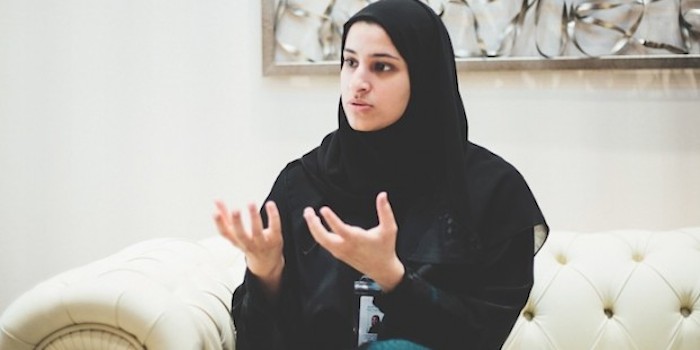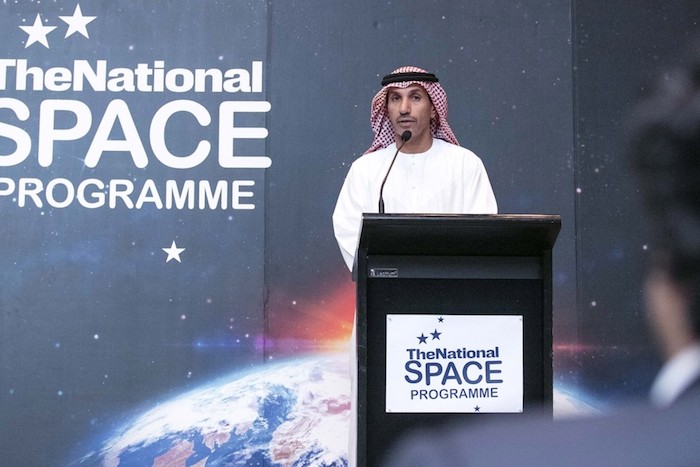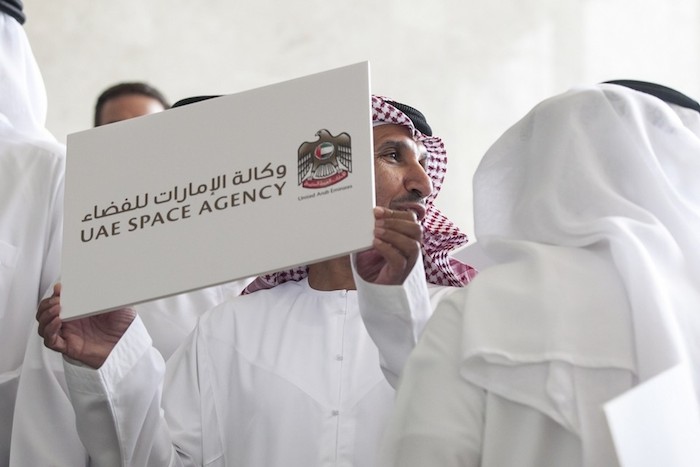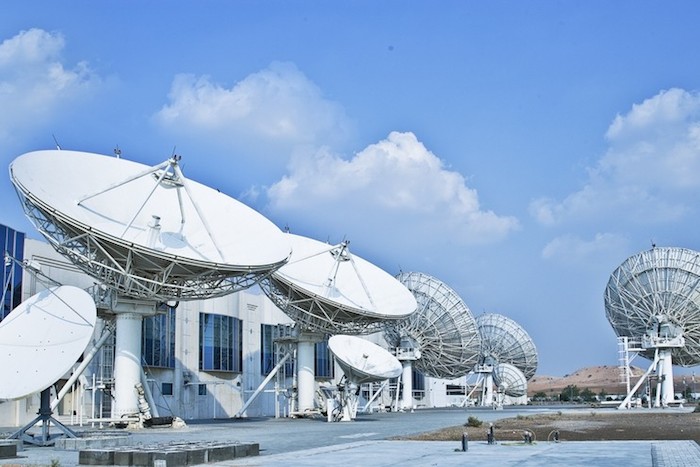.

Science lead on the UAE’s Mission to Mars Sarah Amiri
Amiri discusses everything from the complexities of space and tourism beyond the earth to artificial intelligence and black holes
-
What are the possible spin-off projects that the Mars mission might bring and how could they benefit society – as previously happened with space projects and the creation of mass-market global positioning systems and satellite television for all?
“The beauty of space exploration, especially missions to other planets, is that you encompass a number of scientific disciplines and various disciplines in engineering so it allows you to build capacity and capability in a wide range of implementation areas. Just by getting one investment portion in one project, it allows you to do that.
“Investing in space is a longterm thing that allows you to have those eventual spillovers as we’ve seen with other countries and other organisations like NASA. GPS is a good example to highlight, as is magnetic resonance imaging. But it takes a while to first build an ecosystem and an understanding, and belief in the outcomes of science and technology. Then you move to the spillovers intoother sectors in the economy.”
And do you expect to see a dominant player emerge in terms of space tourism despite the recent Virgin accident and could that new force emerge from the Middle East given the global rise of the ‘big three’ Gulf airlines and the United Arab Emirates space programme plans?
“The development from a technological perspective to get to the point of having systems capable of safe access to space for human beings – whether it’s for science or tourism – is picking up a lot of speed and there are a lot of players that have a big stake in it with large investments. The future looks good for tourism and scientific access to space.”
Okay and will you build a spaceport as part of the Hope programme or will you use an external third party in terms of the location where you will launch the probe?
“For such missions, you always rely on known launch providers because you don’t want to take on the added risk. The main objective of this mission is scientific; it is the hope message of what we can do to our science and technology sector. That is the essence of what we are trying to build and so we will rely on the launch providers that already exist around the world.”
With that in mind, is there a specific launchpad that you would like to use?
“We are currently evaluating most of the major launch providers. The location of the launch is very important.”
Because the period when the close alignment of the planets occurs is a small window right?
“Yes, the location very much comes into play there in order for us to get the correct trajectory towards Mars.”
How short is the launch window – when Earth and Mars are aligned at their closest point in the two-year orbit cycle – in July 2020 and what is the contingency plan if you miss this deadline?
“We have a few weeks in July 2020 when we can launch. We have a lot of measures on a project management level that will allow us to deliver the spacecraft in time for it to be launched. It’s a combination of good project management and good risk management, and an overall understanding of the constraints of the timeline.”
Could Hope eventually lead to a manned UAE space mission or will robots be the focus of space exploration forever more?
“We are trying to acquire all of the knowledge areas and cornerstones required to build such space missions, be it manned or otherwise. What we are aiming for is getting to Mars. As ambitious as the mission is and as ambitious as the country is, we don’t see a ceiling as to where the next mission will take us.
“The team here will be capable of rising to any challenges provided by the government and leadership. It’s all about alignment with the vision of the country and the capacity we have and how we feed that into the knowledge economy. Any decisions about future missions will be made at a leadership level.”
‘Hope’ is a great name for the mission but if it fails, the name could cause real embarrassment could it not – critics might start to say ‘we have witnessed the failure of hope’?
“It won’t cause any embarrassment because hope is a mission, it is not the probe that is being sent. The entire mission of developing these capabilities and getting to the point where you are able to launch is already a success. Getting it on a rocket, getting to Mars and getting the science out of the project are simply additional successes beyond that.
“In no way can it be a failure because it is about the message of hope. Taking the leap of faith that you can do it and that it is possible is the thing that is very important. It is at the core of the mission.
With the space industry growing in prominence, is there a risk that the global superpowers might attempt to weaponise space – we all heard the rumours in the past about the militarised United States space shuttle and it is a fact that China deliberately exploded a satellite in orbit, back in 2008, as a military test?
“As a country, the UAE is committed towards the peaceful use of outer space. We are observing members in the United Nations Office for Outer Space. We want the entire world to focus on space technology for the benefit of humanity and the continuation of human knowledge.”
Many say the International Space Station has been an example of nonpolitical international collaboration at its best. However, with Russia and the United States now on the verge of a new Cold War – are the wheels coming off this project?
“The beauty of space is that what happens at a political level does not infiltrate down to space sciences. It is one community. It is not divided by country, region or political background. That allows for missions to flourish and go beyond problems that might exist between countries. Space is the essence of international collaboration and most players understand that. There is actually a drive towards retaining international collaboration in space missions.”
How many people will be working on the Hope project and what percentage are Emiratis given that the initiative is also designed to upskill the local workforce?
“By 2020 we will have around 150 Emirati engineers, data analysts and scientists working on this project. We will alsoinvolve a lot of the universities here in the scientific aspects to get this mission done.”
The probe is designed to orbit the red planet until at least 2023 and, possibly, until 2025. Why not extend the project beyond this date – do you think the research will have run its course by this point or are there technical reasons for the 2025 switch off?
“The two-year lifetime of the mission is actually answering to the science objectives. We want to understand the dynamics of the atmosphere over a Martian year, which is two full earth years. We want to understand the changes in seasons throughout the days of the year. The time period will allow for us to capture the amount of data we need. The spacecraft itself can operate beyond that, it is designed to have a longer lifetime.”
Potentially, there could be another mission after that period then?
“There could, indeed, be add-on objectives that we can bring into an extended mission and that’s natural for such projects.”
The autonomous star-tracking system – or spacecraft’s brain – that will allow the craft to reposition itself using constellation patterns, without any direction from mission control which will be a 20-minute radio signal away, sounds like an artificial intelligence programme. Is that the case?
“It is. Such missions commonly go beyond the realm of space and this craft needs to think for itself pretty much, and to be dynamic enough to make decisions for itself. It will also need to be able to collect all the necessary data required.
“It will be operating beyond the line of earth so it’s a very harsh environment. The spacecraft will have very limited contact with earth. That moves us towards having a system that is highly intelligent and is able to react to sudden changes around it. It needs to protect itself and get to the destination.”
Following on from that, what’s your view on whether AI is a good thing for humanity or something that could turn out to be Frankenstein’s monster?
“I am very optimistic about it because the way the world is developing and technologies are developing, if we don’t go for AI and understanding it more we will start stagnating as a human race. Our nature is always to want to know more and to get more done. You need such AI systems to be able to do that now. It is inevitable, we require it to get a lot of things done in the world today.”
Jumping back to the mission, you have said that the oval spacecraft will weigh only as much as a small car. But what will be the total budget for this small car and the entire mission?
“The overall budget is still being formalised because it will require a lot of design decisions but, as with everything we do in the UAE and Dubai, it will be very cost-effective as a mission. The budget will be tight and we will need to stick to it. We are currently in the process of finalising it.”
One of the stated aims of the mission is to study the weather systems and the atmosphere on Mars. Why is this relevant to humanity and the earth?
“There are a lot of questions we have about Mars itself and how it evolved from a planet that had running water to a planet that is very dry and arid – and uninhabitable. Millions of years ago, it was capable of accommodating life and was actually in an ideal position to do so. But there are no traces of life found.
“However, from what we know about the climate, it had an environment that could have hosted life. Then it transformed suddenly to what we see today. The understanding of that evolution and what is currently happening on Mars today will allow us to understand more about the earth itself.
“If you want to learn about a society or a person, you will always want to learn about the surroundings and the dynamics. We need to understand how earth’s neighbours have evolved and where it sits in comparison to its neighbours. Previously, we had only small windows and glimpses of the weather systems on Mars. We will have a longitudinal study in place and a much bigger sample of data to work from.”
Given that the atmosphere on Mars has been decaying and drifting off into space for some time, is this programme a result of concerns around runaway climate change here on earth and how we might tackle, or at least adapt, to that eventuality?
“It is about climate change here on earth and how that planet evolved over time. Mars is half the size of earth so it evolved faster than the earth did. We want to work out what happened to the water on the surface of Mars. Mars has very similar river bed and valleys systems to earth.
“We need to know what really happened and what got the atmosphere to a point where it does not allow for liquid water to flow on the surface. This information will allow us to better understand the changes that are happening here on earth. It will help us to know what earth could look like down the line and how can we adapt to that scenario.”
But is this data going to give us the potential simply to adapt to climate change or halt and, even, reverse it?
“Well, humanity wants to survive. That is how ambitious we are and that is human nature to ensure our survival as a race. We will do all that we are capable of doing in the future to sustain humanity on this planet.”
Do you expect to find any new forms of life on Mars?
“We are not studying that but life anywhere in the entire universe is possible. We are not an anomaly, a one-off. That doesn’t statistically make any sense.”
Who are the international partners for the mission and how will the collaboration work on a practical level?
“We are working with three academic institutions, which have 65 years of experience in space systems between them. They are professional schools. And they are the University of Colorado, the University of California Berkeley and Arizona State University.”
And are you working with the likes of NASA as well?
“No, we’re not.”
The UAE has signed the United Nations Convention on the registration of objects launched into Outer Space already. Will it also sign up to the Space Protocol and the Cape Town Convention of International Interests in Mobile Equipment so that there is a clearly established set of regulatory standards – and an institutional and legal framework to organise and enable commercial activities?
“The UAE has always been driving to align with all international conventions. I don’t foresee that such a mission would not adhere to that. We will always abide as a country to the international laws.”
Are there any projections for a return on investment in relation to the UAE space programme – is this applied research or basic research, or a hybrid of the two?
“It is applied research with a bit of basic research added in. I’ll echo what the ruler of Dubai Sheikh Mohammed said when he was asked how much he was investing. He stated he was investing in his people, in the development of the economy and this is also a direct investment into the youth; developing an entire generation that is capable of creating other things in the knowledge-based economy that we are striving to achieve by 2021.
“The return on investment is intangible at this point but it will have a long-term impact on the economy. And in terms of what the next generation will be able to create moving forward from this programme.”
The space industry is worth an estimated $300bn. What percentage of that is the UAE aiming for in the future?
“With the creation of our agency, we are looking into expanding into the space race more and more. We are looking at developing different space missions. We have been in space for about 20 years but a good indication that we will contribute more to the entire sector is the creation of this agency.”
What funding guarantees are there for the project, given that a number of programmes were halted – albeit temporarily – as a result of the 2008 economic crisis and the fact that many respected economists are talking about another global economic shock coming down the line?
“The leadership has been committed for almost 10 years now, even during the peak of the financial crisis. That is a very clear indication that support from the government for space missions is there. To have a flourishing science and tech sector, you need to be future-proofed and insulated from any global problems.”
What do you think of the work going on at CERN in relation to black holes and so on – is it a positive thing for society or dangerous because you are opening Pandora’s Box and nobody really knows what could happen?
“I’m all for science and exploration. It is about answering questions and there were a lot of Pandora’s Boxes that were opened centuries ago and were considered at the time to be obscene and blasphemous declarations – like the earth revolving around the sun. If we had not triggered such questions and done those investigations, we wouldn’t have got to the point where we are right now and this stance would also prevent our progress in the future.”
Staying with the theme, do you believe there are parallel universes and worm holes – dimensions beyond those we know of – or is this just the stuff of science fiction?
“My personal belief is that I don’t discredit anything unless we have the scientific merit to do so. If the theories are there, they are based on some form of scientific observation. It’s better not to discredit such things until we have hard evidence that they are not true.”
There are also many scientific theories in relation to the Big Bang. Which one do you subscribe to?
“I don’t have a specific one I subscribe to because a lot of the theories differ in the details but the overall concept has a lot of proof. We do have a lot of images looking back into time. This indicates that such a thing did happen. It’s a topic that is under continuous debate and exploration.”
Finally, will humans ever occupy Mars or other planets beyond earth in the future – do you think?
“If we have the necessary technology that means we are capable of doing so, it could be a possibility in the future.”
Quelle: GulfBusiness
-
Update: 21.12.2015
.
UAE Raumfahrtprogramm: Alles, was Sie wissen müssen

Mohammed Al Ahbabi, Director General of the UAE Space Agency, speaks at a press conference announcing The National Space Programme. Silvia Razgova for The National
.
Down here on Earth, six years is a relatively short space of time but for the UAE’s ambitious young space industry, it is long enough to move forward by light-years.
The country’s first fully government-owned satellite was launched into space in 2009. Since then the UAE space sector has gone into overdrive, largely thanks to a series of bold government initiatives.
Here is an outline of the 10 key players and initiatives in the UAE space business:
Emirates Mars Mission
The UAE’s aim to send an unmanned probe to Mars is its most ambitious plan yet. The UAE Space Agency’s Mars Mission is scheduled for launch in 2020, although it will not reach the Red Planet until the following year, which marks the UAE’s 50th anniversary. “This is the Arab world’s version of president Kennedy’s Moon shot – it’s a vision for the future that can engage and excite a new generation of Emirati and Arab youth,” says Yousef Al Otaiba, the UAE’s Ambassador to the United States.
The UAE Space Agency
Established in 2014, the agency directs national space programmes that will have direct benefits to the country’s economy and human capital. It creates space policy and regulation, as well as supporting the development of engineers and scientists. In October, the Space Agency gained membership of the International Space Exploration Coordination Group, making the UAE the first Arab country to join.
The National Space Programme
This newspaper in November announced a partnership with the UAE Space Agency and Boeing to launch its own space initiative. The National Space Programme features two competitions – Genes in Space, which will see students from across the UAE compete for the opportunity to have their experiments launched into space and conducted by scientists on board the International Space Station; and the Satellite Launch project.
Khalifa University Space lab
The Abu Dhabi educational institution this year opened what is believed to be the region’s first space lab. The Spacecraft Platform for Astronautic and Celestial Emulation (Space) laboratory has special unmanned aerial vehicles, robots and sensing systems that help mimic actual conditions in space.
Space Research Centre
Announced in May, the planned research centre in Al Ain – a partnership between the UAE Space Agency, UAE University and the Telecommunications Regulatory Authority, represented by the ICT Fund – is set to cost almost Dh100 million over five years. It is intended to act as an incubator for space research and innovation at the Federal level.
Yahsat
There are already spacecraft being controlled from the UAE – from the very Nasa-style mission control room at the satellite operator Yahsat. The subsidiary of the government-owned Mubadala Development already has two satellites in orbit and a third set to blast off in 2016. It offers a range of communication services including voice, internet and TV. The Al Yah 3 satellite, set to go live, after launch, in early 2017, will extend Yahsat’s broadband services to 19 countries across Brazil and Africa.
Mohammed bin Rashid Space Centre
MBRSC was founded by Sheikh Mohammed bin Rashid, Vice President of the UAE and Ruler of Dubai, in 2015 when it was integrated with the existing Emirates Institution for Advanced Science & Technology (EIAST). The centre’s projects include satellites and the Emirates Mars Mission. It has scientific laboratories and research facilities based in Dubai, as part of its broader goal of building a sustainable knowledge-based economy.
DubaiSat, KhalifaSat
DubaiSat-1 was the first fully UAE-owned satellite. It was launched in 2009, then part of EIAST, which was later rolled into MBRSC. A second DubaiSat blasted off in 2013; KhalifaSat, the first satellite fully manufactured by Emirati engineers in the UAE, is expected to enter orbit in 2018.
Thuraya
DubaiSat-1 blasted off in 2009, but the UAE mobile satellite communications company Thuraya was years ahead of it. The company launched its first satellite, Thuraya-1, in 2000, as the Middle East’s first mobile telecommunication satellite. The private company has investors from the United States, United Kingdom and Middle East.
Virgin Galactic
Abu Dhabi-owned Aabar paid US$280 million for 31.8 per cent of Virgin Galactic in 2009, later raising it to 37.8 per cent, with talk of the emirate becoming the location for the second of Virgin’s Spaceport facilities. Richard Branson’s already famous company, billed as the world’s first commercial spaceline, has sold hundreds of $250,000 tickets. But it is now trying to recover from a major blow in 2014 when a test flight exploded over the Mojave Desert in California, killing a pilot.
.

Mohamed Al Ahbabi holds up a sign as he and other guests pose after a press conference announcing The National Space Programme,. Silvia Razgova for The National

Thuraya, the satellite phone subsidiary of Etisalat. Courtesy Thuraya
Quelle: The National Business
5347 Views
